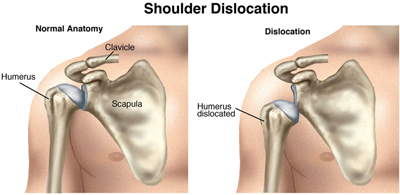 New Health Guide
New Health Guide
When your shoulder joint moves out of place, it becomes quite painful, especially if it is actually dislocated. A dislocated shoulder occurs when the upper part of your arm bone feels like it pops out of the cup-shaped socket that is surrounded by the shoulder blade. As the most mobile joint, the shoulder is more likely to be dislocated than any other bone.
After a shoulder injury, seek medical attention soon if you believe it may be a dislocated shoulder. Usually, with proper treatment and care, full use of the shoulder returns within a few weeks. Sadly, after a shoulder dislocation occurs, you become more susceptible to it in the future.

Many wonder what actually happen when you dislocate your shoulder, and how they will know when it does. Since a shoulder dislocation occurs when a bone pops out of another bone, it will be quite painful. The shoulder will take on a square, rather than round, appearance and you will be unable to move the arm.
If it appears that you have a dislocated shoulder, seek medical attention as soon as possible. As you are waiting for the doctor or physician to see, be sure that you do not move the joint as any movement may worsen the injury and lengthen your recovery time. Furthermore, have someone hold ice over the shoulder blade (on the upper left or right edge of your back) to reduce swelling from blood and fluids as well as to alleviate the pain.
The shoulder joint is easily dislocated because it can move in almost every direction – meaning it can also be dislocated by movement in any direction. Generally, a dislocated shoulder is through the front, but partial dislocations can occur in any of the directions. For a dislocation to occur, it will take a relatively strong force that pulls the bones out of place or extreme rotation of the shoulder joint. The following are the most common causes of a dislocated shoulder:
The following treatments are recommended in the days and months following a dislocated shoulder injury:
In the weeks immediately following the injury, you will want to refrain from using the injured arm and allow it to heal for at least two to three weeks, unless otherwise specified by a doctor. This should be enough time for the soft tissue to begin to repair, at which point a physiotherapist will work with you and your specific injury to determine which exercises would be best. These exercises will be designed to relieve the pain, return the shoulder muscles’ strength, and reduce the stiffness from the muscles not being used for a while.
NOTE: Keep in mind that the above treatments should help, but may not completely heal your shoulder. For some, healing may only take a few weeks and for others, healing may take several months until they have regained full strength. Most can resume normal daily activities after two weeks, but any heavy lifting or impact sports should be avoided for one to six months, depending on what the orthopedic surgeon advises.